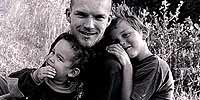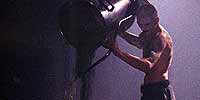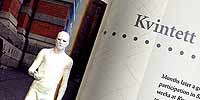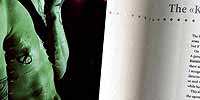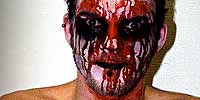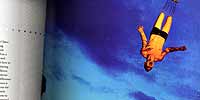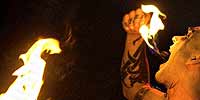 |
 Ten Years of Pain by Håvve Fjell - Review by Shannon Larratt |
||||||||||||||||||||||||||||||||||||
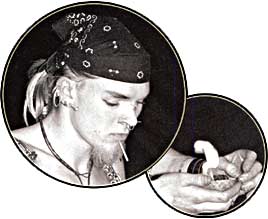
Each time I would try to aim a bit higher; cut a bit deeper, burn a bit longer or push more needles into my legs. Of course, no one around me would understand why I did these things to myself, and I could not explain. This led me to do my business in private and try to hide the results from family and friends.Sound familiar? In 1991 Håvve traveled to Brazil to develop his skills. In Brazil he met other performers, and did his first fakir show — to an audience who was not expecting or desiring his style of show, and jeered him with taunts of “disgusting”, “sick pervert” and “ugly”.
The rest of the night, I hid. I was too ashamed to see the organizers or talk to anyone. However, two good things came out of that particular night. That night, my girlfriend, Monica, conceived our first son, Kai. In addition, I learned an important lesson about performing in public: it is not what you do, but how you present it that matters.His confidence returned along with his return to Oslo, where he put on another show with friends (much more successfully) and started thinking about combining the fakir element with performance and stage art. Along with his friends Eirik and Roberto he decided that maybe they could even make a little money if they built a show around fire, juggling, fakirism, and music, and in 1993 PSI (Pain Solution Inc.) was founded. The first show was a success, but they quickly lost their backing band. The group shuffled members for a while, and Håvve took courses in street theatre, mime, clowning, and acting, and became more and more serious about the professionalism of his show. He returned to Brazil for some time and then back to Norway where he slowly re-tooled his shows for a broader audience — Pain Solution was getting TV gigs, many shows, and media appearances — and also worked with puppet theatre and other art-forms.
We were mostly doing fire stunts and I had padlocks sewn to my torso, this was quite new to me at the time and I was dancing wildly. It came to the point where I felt I was loosing contact with the floor, as if I was dancing without touching the ground. What I felt was pure pleasure. I watched the crowd from above and was about to fly up, and out from the stage. I do not know what really happened, but it was suddenly very quiet. A technical problem with the sound system had put an end to my almost leaving my body experience.For Y2K Pain Solution was contracted to perform at the largest millennium event in Norway, a huge fire show on New Year’s even in Oslo. After being the pinnacle act in front of 200,000 people Pain Solution started getting larger contracts for custom performances, and Håvve began building a network of actors, contortionists, jugglers, and other performers to work with as shows dictated. Shows got even larger, and in 2001 Pain Solution co-produced Ringen with the Haugesund Theatre, a modern circus group. Large projects always put a lot of stress on a group, and Håvve decided to revert Pain Solution back to being a solo production. He was then invited to do a series of performances for the Industrial Art Museum in Oslo, and presented them with a plan to do a sculptural or “poetic” suspension. They turned him down, saying that he would scare off their “elderly guests”. Håvve was furious — he’d been promoting the event for three weeks, and his art was being muted.
I saw no reason in arguing, nor did I see any reason to accept being excluded from the programme. I decided to hold a demonstration against censorship, at the museum on that given Saturday. I wrote a new press release explaining the situation. When I sent it out, I made sure they got a copy at the museum.  However, after this successful series of performances (with a great deal of media and critical attention), Håvve again found himself alone and in debt — for the first time in his life, he had to get a job. Of course, with no education or experience, the best he could do was two part-time jobs — and he feared that a full-time job could interfere with his ability to continue developing Pain Solution. Kvintett had given him a new area to explore as an artist and a fakir — his own personal approaches to pain. His performances became more esoteric, and Håvve became an explorer and researcher as much as an artist.
In the west, our culture brings us up to perceive pain exclusively as a negative experience. No matter how small the injury might be, the most important action taken is to comfort the child. I am not saying that is wrong, but in many cases parents end up teaching their children to fear pain. If a child is bleeding, the hysteria is even worse....which brings the specific history of Pain Solution up to date.
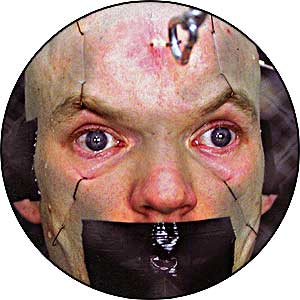 Addressing something too many amateur performers overlook, Håvve warns about some of the accidents that have happened on stage, including one horrific experience where he breathed in a lungful of paraffin, leading him to ten days hospitalization after the performance. Other shows left him with serious burns, and another with cuts in his hand that resulted in permanent nerve damage. Like many of us, he’s had last minute supply and preparation problems, rigging failures, and other mishaps. “Shit happens and the show must go on!” The conclusion to the book contains commentary from many of the other members of Pain Solution mentioned in the book, both performers and technical staff. It also contains some interview excerpts and fine arts analysis of Håvve’s performances (“In search of a lost pain” by the Bureau of Contemporary Art Praxis, Rijeka, Croatia, and “Toward the aesthetics of pain” by Stahl Stenslie, Academy of Media Arts, Colgne Germany), commentary from Målfrid J. Frahm Jensen and Per Johan Isdahl (Ullevål University Hospital, Oslo) on the self-harm aspects, and from Siv Ellen Kraft (University of Tromsø, Norway) on the religious aspects. The book then finishes with a short FAQ. This really is a remarkable book. My review does not do it the justice it deserves. I literally believe it is the only book that has been able to take such a snapshot. I do not believe that any body modification book collection can be called complete without this book, and I believe this is essential reading for anyone involved in performance or body art as well as those interested in art history and body-art/modification/play-history.
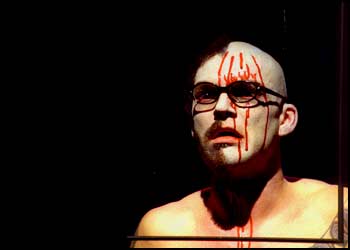
As far as I know BMEshop is the only place this book is available online. Because I believe in it so strongly I have given up all royalties and commission on its sale in order to ensure the best possible price for you. Please note that we only have a few in stock right now, so if you visit the page and it’s sold out, please be sure to add your name to the “tell me when it’s back” list.
PS. Be sure to check out the Pain Solution website at www.painsolution.net!
This page and its contents are © 2004 BMEZINE.COM and Shannon Larratt. All rights reserved. Requests to reprint must be confirmed in writing. For bibliographical purpose this review was published January 21st, 2004 in Toronto, Canada.
|
|||||||||||||||||||||||||||||||||||||
